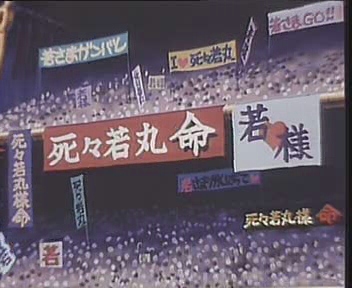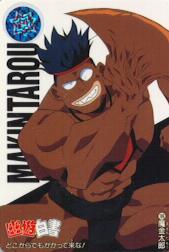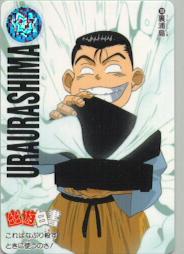

"Shishiwakamaru" is written with the kanji for "death" "repeat the last kanji" "young" "-maru." All clear?
Yeah, me too.
Okay, break it down like this: "Shishi" means "death death," and though I'm not certain exactly what a repeated word means in names, it's a safe bet that it's an intensifier.
"Wakamaru" is a real Japanese name, the kind of name which boys of the samurai class were given before they were old enough to have adult names. Shishiwakamaru's fans consider it his real name—the girls call him Waka-sama and the men just yell "Koroseee, Shishiwakaaa!" It's made of two elements: Waka, "young," and -maru, a boys' name ending. So "Shishiwakamaru" means, roughly, "Youthful death."
Eeewwwwww.
A Japanese fan who identified him/herself only as "A" told me that there was an alternate translation. "Shishi" means "lion," which is written with a single kanji. Writing "lion" with the double kanji for "death" is a literary pun. Therefore, "Shishiwakamaru" could be roughly translated as "youthful lion," with a subliminal emphasis on the lion's deadliness. Very elegant. (Thank you, A! I'd thank you more personally, but my email account ate your email.)
Shishiwakamaru's name is a reference to Ushiwakamaru, the boyhood name of Minamoto no Yoshitsune. Yoshitsune defined the word "bishonen." This is what Ian Buruma has to say about him in Behind the Mask:
The most famous bishonen in Japanese history is arguably Japan's most popular hero, immortalized in numerous plays, films, books, comics and television dramas. ... He was born in the twelfth century and his name was Minamoto no Yoshitsune. Like many bishonen Yoshitsune was raised by an older man, in his case a fatherly monk in a Buddhist temple near Kyoto—monks, one would believe, had a special fondness for taking good care of bishonen.Despite his fey good looks, in the legend at least, Yoshitsune became a skilled and enthusiastic sword-fighter. One of the most famous legends of his early years is his first encounter with Benkei, the giant warrior monk. It is said to have taken place on the Gojo bridge not very far from where the main Kyoto railway station is now.
Benkei needed funds for his temple and to this end he promised to rob a thousand passers-by of their swords. He got as far as 999 with relative ease when he saw a slender, effeminate youth approaching, playing a melancholy tune on his flute. At first the giant monk refused to fight this girlish boy who was looking up at him through his long, curled eyelashes. But he needed the money badly and drew his sword. As if by some miracle, however, he was completely outclassed. With a few elegant flicks of his slender wrist Yoshitsune managed to knock down the giant with his painted fan. ...
Benkei was so impressed by his bishonen adversary that he sword to serve him for the rest of his life as a retainer. [Behind the Mask, pp. 132-3]
When Shishiwakamaru demonstrates his sword's true powers to Genkai, he says, "Even the famous Benkei preferred to step aside in the face of this sword." ("So where is Benkei now?" ask all the fanficcers...)
The temple where Yoshitsune trained was the Kurama Temple. Yes, that Kurama Temple, the one on Mount Kurama, which our favorite Kurama was named after. Coincidence? I think... so. But neat, ne?
By the way, later in the chapter, Buruma mentions that "according to a contemporary witness, [Yoshitsune] was a 'small, pale youth with crooked teeth and bulging eyes.'"
All of the members of the Uraotogi team have similar names—long, convoluted kanji salads. (Except for Suzuki, whose name is the Japanese equivalent of Smith or Jones. A sorbet, to cleanse the palate.) Their names are all references to Japanese folktales and legends. Glaringly obvious, tremendously popular, heard-it-in-kindergarten folktales and legends. Here's a rundown of the correspondences I've been able to find:
 | Makintarou: Kintarou was the boyhood name of Kintoki Sakata, a Heian warrior who became famous as one of the retainers of Minamoto no Yorimitsu. Kintarou legends are tremendously popular in Japan, and there are dozens of them. As a baby, Kintarou wore a bib with the kanji for "gold" on it; Makintarou wears a bib with a kanji which is a hybrid of "gold" and "magic" (the "Ma" of Makintarou). Kintarou was famous for his strength; Makintarou is tremendously strong. Fat lot of good it does him. |
 | Kuromomotarou: Momotarou is the name of the hero of the fairy tale "Peach Boy." Over the course of the story, Peach Boy befriends a monkey, a pheasant, and a dog, who help him to defeat an ogre; Kuromomotarou changes into monkeylike, birdlike, and werewolf forms to... well, to really annoy Hiei. |
 | Uraurashima: Urashima Taro is a fisherman who, because of an act of kindness, is allowed to marry the daughter of the Sea King. He and the princess live happily under the sea... until Urashima asks to go home to see his old parents. Like Urashima, Uraurashima is a fisherman. Unlike Urashima, Uraurashima is a sniveling, gloating, nose-picking little creep. The first "Ura" of his name means "flip side, reverse," so perhaps he's the dark side of Urashima Taro. |
 | Suzuki: Oh, geez, I'm not going to even try to look this one up. "Suzuki" is as common as "Smith" or "Jones." (It's written with the kanji for "bell" and "wood." It is not written with the kanji for "sea bass" or "perch," which several helpful readers have suggested as a translation.) If anyone has a clue which fairytale character Suzuki's name refers to, drop me a note and I'll give you credit. |